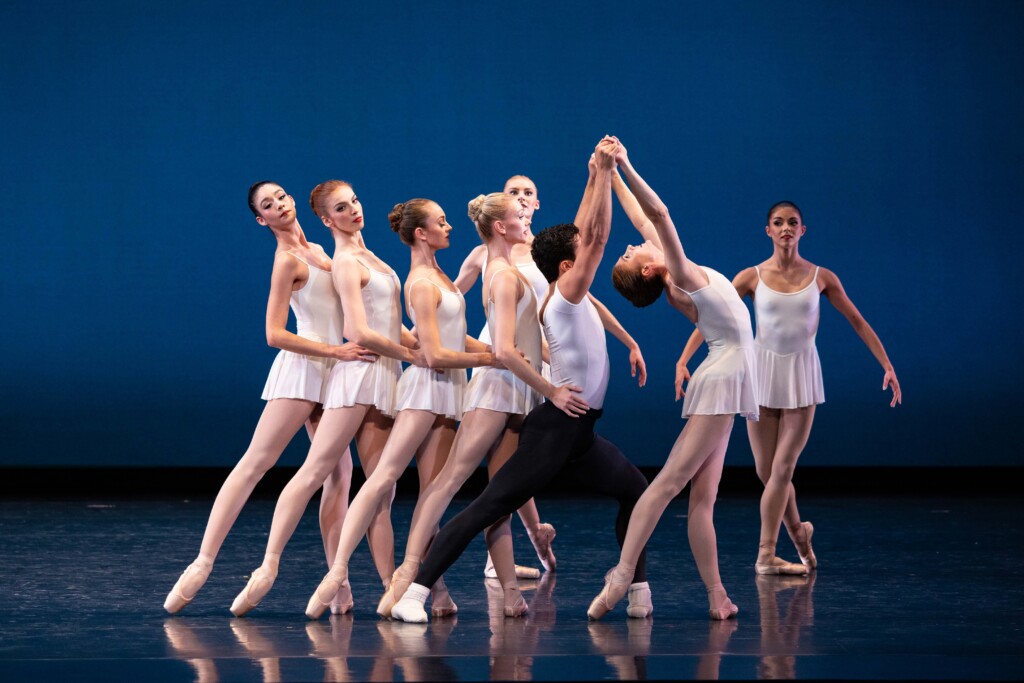EDITOR’S NOTE: The Utah Review is pleased to present this review by guest writer Chris Myers of Argyle Arts.
Good artistic programming can result in a performance that is more meaningful than the sum of its already formidable parts. Paired properly, works interact with one another, providing new perspectives and highlighting themes that might otherwise go unnoticed. This alchemy was on display at Ballet West’s Rodeo, which opened at the Capitol Theater in downtown Salt Lake City last Friday. Three very different pieces by very different choreographers came together to create a profoundly moving evening.
The performance began with George Balanchine’s Concerto Barocco, set to Bach’s Concerto for Two Violins. Bach and Balanchine have a lot in common. Both are known for their exquisitely sculpted form and elegant structural perfection. From a performer’s perspective, both demand a level of technical skill that can result in sterile performances if artists forget to bring their humanity on stage.
Balanchine was also a uniquely musical choreographer. In addition to ballet, he was trained as a classical pianist and composer. He frequently learned the music for his ballets by creating and playing his own piano reductions of orchestral scores. His choreography reflects this “under the hood” knowledge in the intricate and often surprising ways in which movement reflects sound.
Concerto Barocco is no exception. There are many ways in which two soloists can interact — dialogue, collaboration, competition. Violinists Aubrey Woods and Emily Day-Shumway delivered effortless virtuosity and intimate interplay in their performance, while Katlyn Addison and Amy Potter added new layers of character as the music unfolded. Potter was the very picture of classical elegance, and Addison brought a vibrancy and innate understanding of the piece that made her performance seem organic, as though these moments of technical perfection were welling up from within and flowing spontaneously from her. There were even moments of dry humor, as the intertwining violin lines led the two dancers to try “upstaging” one another. These are performers who certainly did not forget to bring their humanity.
Some of the more touching moments, however, developed when the soloists were separated by the arrival of Brian Waldrep. Partnering with him, Potter delivered flowing lines of great beauty that provided a moving foil to Addison’s determination and strength as she continued to dance on her own.
Concerto was followed by Jiří Kylián’s Return to a Strange Land, set to solo piano pieces by Leoš Janáček (performed by Vera Oussetskaia-Watanabe). Like so much of Janáček’s music, this piece finds a deep beauty in alienation and loneliness. Return to a Strange Land delivers a restrained passion that seems almost fearful of its own power. This is interaction without connection. You’re barely aware of the ongoing lack of eye contact. Dancers touch and entwine, but do so while looking away from one another. It’s not until true connection does occur that you realize how much you’ve missed it.
This disconnection makes it all the more stirring when, in the most powerful moment of the piece, Jordan Veit turned and, for the first time, truly saw Chelsea Keefer. He reached to her while sliding to the ground, and, in a move both tender and desperate, she clung to him in a fetal hug. The impact on the audience was immediate and heartfelt.
The evening’s headliner piece requires the fewest words. Rodeo was a rambunctiously energetic, laugh-out-loud audience pleaser — the perfect end to this program. Jenna Rae Herrera stole the show as the tomboyish Cowgirl, infusing the character with hope, innocence, and genuine humor. Tyler Gum’s Champion Roper was a perfect match for her, playing the role with charming goofiness and irresistable sincerity.
It was intriguing how the programming provided new context for this story. Rodeo is often thought of as a feel-good girl-meets-boy story… and it is. But after the competition and solitary strength of Concerto, and after the lonely desperation of Return, it was hard not to feel a deeper empathy for the Cowgirl’s undeserved alienation from a society which refuses to provide a place for her. This context added unexpected layers of tragedy to her comic attempts at “girling herself up” as she sought to gain acceptance.
And, in a surprising way, Rodeo retroactively revealed aspects of hope in the prior two works as we moved toward our happy ending, in which the outsider discovered that not fitting in was always her greatest asset, because it’s the only way that she can be loved for exactly who she is.
Ballet West has three more performances of Rodeo, through Nov. 12.



